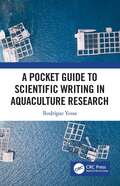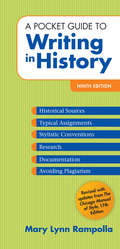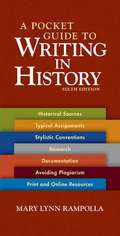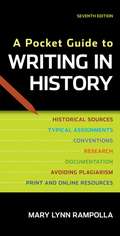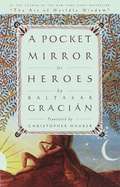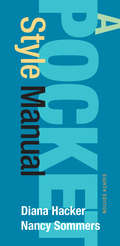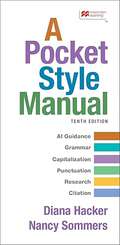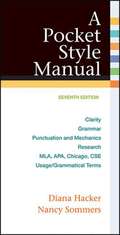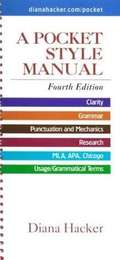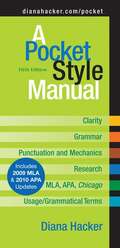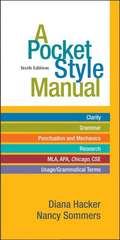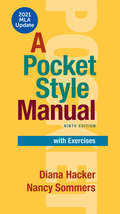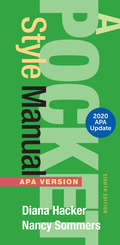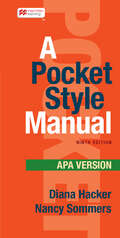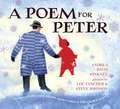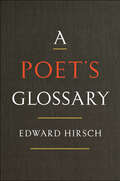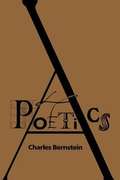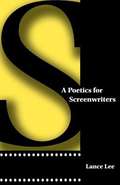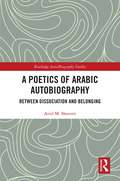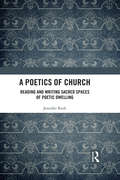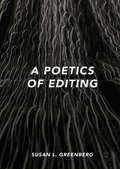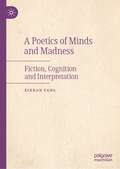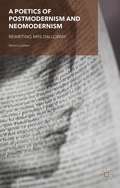- Table View
- List View
A Pocket Guide to Scientific Writing in Aquaculture Research
by Rodrigue YossaWriting for a high-quality scientific aquaculture publication is challenging, and many students and early career aquaculture scientists find the task daunting. Expanding on his popular workshop on Improving Scientific Writing at the 2017 World Aquaculture conference, Rodrigue Yossa provides new researchers with all the tools they need to write abstracts and a variety of articles (original, research reports, magazines, working papers, conference proceedings and more). He also takes the reader step-by-step through the process of reviewing submitted manuscripts and replying to reviewers, as well as understanding research ethics. Each section is accompanied by examples, and attention is focused on providing advice on grammar, how to focus your paper and possible loopholes when writing. A Pocket Guide to Scientific Writing in Aquaculture Research offers a lifeline to aquaculture students and early career researchers getting a grasp on the basics of science communication through writing.
A Pocket Guide to Writing in History
by Mary RampollaA Pocket Guide to Writing in History is a brief, inexpensive, and easy-to-use guide to the writing and research skills needed for undergraduate history courses. Its concise yet comprehensive coverage of every step of the research and writing process--including detailed advice on documenting sources and avoiding plagiarism--have made A Pocket Guide to Writing in History the trusted choice in history.
A Pocket Guide to Writing in History (6th edition)
by Mary Lynn RampollaA portable and affordable reference tool, A Pocket Guide to Writing in History provides reading, writing, and research advice useful to students in all history courses. Concise yet comprehensive advice on approaching typical history assignments, developing critical reading skills, writing effective history papers, conducting research, using and documenting sources, and avoiding plagiarism -- enhanced with practical tips and examples throughout -- have made this slim reference a best-seller. Now in its sixth edition, the book offers more coverage of working with sources than ever before.
A Pocket Guide to Writing in History (7th Edition)
by Mary Lynn RampollaAn essential writing, reading, and research tool for all history students, A Pocket Guide to Writing in History offers a best-selling combination of concise yet comprehensive advice in a portable and accessible format. This quick-reference guide provides a practical introduction to typical history assignments, exercising critical reading skills, evaluating and documenting sources, writing effective history papers, conducting research, and avoiding plagiarism. Building on its time-tested approach, the seventh edition offers expanded, hands-on guidance for writing and researching in the digital age, and additional coverage on working with primary and secondary sources.
A Pocket Mirror for Heroes
by Christopher Maurer Baltasar GracianA Pocket Mirror for Heroes is a mirror because it reflects "the person you are or the one you ought to be." It is a pocket mirror because its author took the time to be brief. And it is a mirror for heroes because it provides a vivid image of ethical and moral perfection to which all can aspire. The Art of Worldly Wisdom by Baltasar Gracian was all but forgotten for three hundred years, until its republication in 1992 turned this lost classic into a New York Times bestseller. Now Gracian, the Spanish Jesuit considered Machiavelli's better in strategy and insight, sets a new standard on the art of living and the practice of achieving. That new standard is the art of heroism--how to be "the consummate person, ripe and perfect: accurate in judgment, mature in taste, attentive in listening, wise in sayings, shrewd in deeds, the center of all perfection."Gracian teaches the reader to be "a giant"--"the greatest person possible, a miracle of perfection, a king." Wit, wisdom, courage, elegance, grace, humility, spontaneity--these are the qualities needed to reach heroism in any occupation. But it is not enough to be wise or graceful: one must learn as well how to manage that talent, how to distinguish a quality fiom its shadow. A Pocket Mirror for Heroes provides "a politics for governing oneself, a compass for sailing toward excellence, an art for reaching distinction with just a few rules of discretion," and it will be wise and witty company for anyone who recognizes--and relishes--the challenges of daily life.
A Pocket Style Manual
by Diana Hacker Nancy SommersYour students need clear, complete answers to their questions about research, writing, and grammar--and they often need them at a moment's notice. As their teacher, you are their greatest resource, but you can't be available 24/7. For help with work in class and at home and especially for questions at odd hours, students can turn to A Pocket Style Manual. The thoughtfully revised seventh edition makes it even easier for students to effectively and independently address their writing and research challenges. With 325 documentation models in four styles and coverage of drafting thesis statements, writing correctly and effectively, finding and evaluating sources, and writing research papers, A Pocket Style Manual supports writers across the disciplines. Our newest set of online materials, LaunchPad Solo, provides all the key tools and course-specific content that you need to teach your class. The LaunchPad Solo for A Pocket Style Manual includes exercises, sample student writing, and LearningCurve game-like adaptive quizzing. To package LaunchPad Solo free with A Pocket Style Manual, use ISBN 978-1-319-01282-3.
A Pocket Style Manual
by Diana HackerA Pocket Style Manual gives you quick answers and expert advice for writing assignments in any course or work setting, including coverage of grammar, style, citing sources, and writing responsibly with AI.
A Pocket Style Manual (2016 MLA Update Edition)
by Diana Hacker Nancy SommersThe thoughtfully revised seventh edition makes it even easier for students to effectively and independently address their writing and research challenges.
A Pocket Style Manual (5th Edition, 2009 MLA Update)
by Diana HackerThe first of its kind, A Pocket Style Manual continues to help student writers get answers to their writing and research questions. Its concise and straightforward content is flexible enough to suit the needs of writers in the humanities, social sciences, sciences, health professions, business courses, fine arts, teacher training courses, and beyond. With its signature Diana Hacker quick-reference features, A Pocket Style Manual has always provided quick solutions to writing problems. Supplemented by the best free and open Web resources, A Pocket Style Manual offers the best value for students. In the Hacker tradition, the new contributing authors -- Nancy Sommers, Tom Jehn, Jane Rosenzweig, and Marcy Carbajal Van Horn -- have crafted solutions for the challenges today's college students face. Together they give us a new edition that provides more help with research writing and one that works better for a wider range of students.
A Pocket Style Manual (6th Edition)
by Diana Hacker Nancy SommersUsed by nearly a quarter million students each year, A Pocket Style Manual is a straightforward, inexpensive quick reference, with content flexible enough to suit the needs of writers in the humanities, social sciences, sciences, health professions, business, fine arts, education, and beyond. Its slim format, brief length, and spiral binding make it easy for students to keep A Pocket Style Manual with them for every writing assignment, in any class. With its signature Hacker handbook quick-reference features--hand-edited sentences, color-coded documentation coverage, user-friendly index entries, and a clean, uncluttered design--A Pocket Style Manual has always provided fast, effective answers to writing and research questions. In the Hacker tradition, new coauthor Nancy Sommers has crafted solutions for the challenges today's college students face. The new edition provides even more help with research writing and supports students in every discipline.
A Pocket Style Manual (Seventh Edition)
by Diana Hacker Nancy SommersThe thoughtfully revised seventh edition makes it even easier for students to effectively and independently address their writing and research challenges. With 325 documentation models in four styles and coverage of drafting thesis statements, writing correctly and effectively, finding and evaluating sources, and writing research papers, A Pocket Style Manual supports writers across the disciplines.
A Pocket Style Manual with Exercises, with 2021 MLA Update
by Diana Hacker Nancy SommersThis ebook has been updated to provide you with the latest guidance on documenting sources in MLA style and follows the guidelines set forth in the MLA Handbook, 9th edition (April 2021).How do I fix a comma splice? How do I cite a Youtube video? No matter your question or the writing project, A Pocket Style Manual with Exercises has the answers. With its quick, easy-to-find explanations and plenty of examples--including full model papers and more than 200 documentation models--this book will become your go-to guide in your English class, the rest of college, and even your career.
A Pocket Style Manual, APA Version
by Diana Hacker Nancy SommersBecoming a college writer means becoming a college researcher, and it can be a challenge for students to keep all of the guidelines and best practices straight for each class. Enter A Pocket Style Manual, APA Version. The eighth edition—with its emphasis on step-by-step how-to instruction that helps students apply writing, research , and citation advice in practical, transferable ways—is a powerful companion for writing in all disciplines. What’s more, it covers all aspects of writing in APA style, including over 100 APA documentation models and 11 sample student papers in diverse genres, from a literature review to a laboratory report to a professional memo. With Pocket’s new research help, tested and trusted grammar and style advice, and digital tools that make practice, tracking, and grading simple, you’ve got the most powerful pocket guide for college writing and research.
A Pocket Style Manual, APA Version
by Diana Hacker Nancy SommersAt-a-glance help for writing in APA StyleHacker/Sommers’ A Pocket Style Manual, APA Style, 9th edition offers quick, authoritative writing advice in an affordable and portable handbook. Whether you need guidance on grammar or help documenting in APA, this handbook has the answers you need.
A Poem for Peter: The Story of Ezra Jack Keats and the Creation of The Snowy Day
by Rosemary Wells Andrea Davis Pinkney Steve Johnson Lou Fancher<p>A celebration of the extraordinary life of Ezra Jack Keats, creator of The Snowy Day. <p>The story of The Snowy Day begins more than one hundred years ago, when Ezra Jack Keats was born in Brooklyn, N.Y. The family were struggling Polish immigrants, and despite Keats's obvious talent, his father worried that Ezra's dream of being an artist was an unrealistic one. But Ezra was determined. By high school he was winning prizes and scholarships. Later, jobs followed with the WPA and Marvel comics. But it was many years before Keats's greatest dream was realized and he had the opportunity to write and illustrate his own book. <p>For more than two decades, Ezra had kept pinned to his wall a series of photographs of an adorable African American child. In Keats's hands, the boy morphed into Peter, a boy in a red snowsuit, out enjoying the pristine snow; the book became The Snowy Day, winner of the Caldecott Medal, the first mainstream book to feature an African American child. It was also the first of many books featuring Peter and the children of his -- and Keats's -- neighborhood. <p>Andrea Davis Pinkney's lyrical narrative tells the inspiring story of a boy who pursued a dream, and who, in turn, inspired generations of other dreamers.</p>
A Poet's Glossary
by Edward HirschA major addition to the literature of poetry, Edward Hirsch’s sparkling new work is a compilation of forms, devices, groups, movements, isms, aesthetics, rhetorical terms, and folklore—a book that all readers, writers, teachers, and students of poetry will return to over and over. Hirsch has delved deeply into the poetic traditions of the world, returning with an inclusive, international compendium. Moving gracefully from the bards of ancient Greece to the revolutionaries of Latin America, from small formal elements to large mysteries, he provides thoughtful definitions for the most important poetic vocabulary, imbuing his work with a lifetime of scholarship and the warmth of a man devoted to his art.Knowing how a poem works is essential to unlocking its meaning. Hirsch’s entries will deepen readers’ relationships with their favorite poems and open greater levels of understanding in each new poem they encounter. Shot through with the enthusiasm, authority, and sheer delight that made How to Read a Poem so beloved, A Poet’s Glossary is a new classic.
A Poetics
by Charles BernsteinThis collection is considered to be more than a work of criticism by the poet Charles Bernstein, it is a poetic intervention into criticism. Artifice of Absorption, a key essay, is written in verse, and its structures and rhythms initiate the reader into the strength and complexity of the argument.
A Poetics for Screenwriters
by Lance LeeWriting successful screenplays that capture the public imagination and richly reward the screenwriter requires more than simply following the formulas prescribed by the dozens of screenwriting manuals currently in print. Learning the "how-tos" is important, but understanding the dramatic elements that make up a good screenplay is equally crucial for writing a memorable movie. In A Poetics for Screenwriters, veteran writer and teacher Lance Lee offers aspiring and professional screenwriters a thorough overview of all the dramatic elements of screenplays, unbiased toward any particular screenwriting method.<P><P> Lee explores each aspect of screenwriting in detail. He covers primary plot elements, dramatic reality, storytelling stance and plot types, character, mind in drama, spectacle and other elements, and developing and filming the story. Relevant examples from dozens of American and foreign films, including Rear Window, Blue, Witness, The Usual Suspects, Virgin Spring, Fanny and Alexander, The Godfather, and On the Waterfront, as well as from dramas ranging from the Greek tragedies to the plays of Shakespeare and Ibsen, illustrate all of his points.<P> This new overview of the dramatic art provides a highly useful update for all students and professionals who have tried to adapt the principles of Aristotle's Poetics to the needs of modern screenwriting. By explaining "why" good screenplays work, this book is the indispensable companion for all the "how-to" guides.
A Poetics of Arabic Autobiography: Between Dissociation and Belonging (Routledge Auto/Biography Studies)
by Ariel M. SheetritThis book examines the poetics of autobiographical masterpieces written in Arabic by Leila Abouzeid, Hanan al-Shaykh, Samuel Shimon, Abd al-Rahman Munif, Salim Barakat, Mohamed Choukri and Hanna Abu Hanna. These literary works articulate the life story of each author in ways that undermine the expectation that the "self"—the "auto" of autobiography—would be the dominant narrative focus. Although every autobiography naturally includes and relates to others to one degree or another, these autobiographies tend to foreground other characters, voices, places and texts to the extent that at times it appears as though the autobiographical subject has dropped out of sight, even to the point of raising the question: is this an autobiography? These are indeed autobiographies, Sheetrit argues, albeit articulating the story of the self in unconventional ways. Sheetrit offers in-depth literary studies that expose each text’s distinct strategy for life narrative. Crucial to this book’s approach is the innovative theoretical foundation of relational autobiography that reveals the grounding of the self within the collective—not as symbolic of it. This framework exposes the intersection of the story of the autobiographical subject with the stories of others and the tensions between personal and communal discourse. Relational strategies for self-representation expose a movement between two seemingly opposing desires—the desire to separate and dissociate from others, and the desire to engage and integrate within a particular relationship, community, culture or milieu. This interplay between disentangling and conscious entangling constitutes the leitmotif that unites the studies in this book.
A Poetics of Church: Reading and Writing Sacred Spaces of Poetic Dwelling
by Jennifer ReekThis innovative book aims to create a ‘poetics of Church’ and a ‘religious imaginary’ as alternatives to more institutional and conventional ways of thinking and of being ‘Church’. Structured as a spiritual and literary journey, the work moves from models of the institutional Catholic Church into more radical and ambiguous textual spaces, which the author creates by bringing together an unorthodox group of thinkers referred to as ‘poet-companions’: the 16th-century founder of the Society of Jesus, Ignatius of Loyola, the French thinkers Gaston Bachelard and Hélène Cixous, the French poet Yves Bonnefoy, and the English playwright Dennis Potter. Inspired especially by the reading and writing practices of Cixous, the author attempts to exemplify Cixous’ notion of écriture féminine—‘feminine writing’—that suggests new ways of seeing and relating. The project’s uniting of Ignatian spirituality with postmodern thinking and its concern with creating new theological, literary and spiritual spaces for women both coincide and contrast with Pope Francis’s pastoral and reformist tendencies, which have neglected to adequately address the marginalisation of women in the Church. As Francis has called for ‘a theology of women’, of which there are, of course, many to draw from, this volume will be a timely contribution with a unique interdisciplinary approach.
A Poetics of Editing
by Susan L. GreenbergThis original and authoritative book offers a first-ever attempt to define a poetics of the editing arts. It proposes a new field of editing studies, in which the ‘ideal editor’ can be understood in relation to the long-theorised author and reader. The book’s premise is that editing, like other forms of ‘making’, is mostly invisible and can only be brought into full view through a comparative analysis that includes the insights of practitioners. The argument, laid down in careful layers, is supported by a panoramic historical narrative that tracks the shifts in textual authority from religious and secular institutions to the romanticised self of the digital present. The dangers posed by the anti-editing rhetoric of this hybrid romanticism are confronted head-on. To the traditional perception of editing as the imposition of closure, A Poetics of Editing adds a perspective on a dynamic process with a sense of the possible.
A Poetics of Minds and Madness: Fiction, Cognition and Interpretation
by XINRAN YANGThis monograph aims to explore the mind-narrative nexus by conducting a cognitive narratological study on the mad minds in fictional narratives. Set on the interface of narrative and cognitive science (cognitive linguistics, cognitive psychology and cognitive neuropsychology), it adopts an indirect empirical approach to the fictional representation of madness. The American writer Ken Kesey’s novel One Flew Over the Cuckoo’s Nest is chosen as the primary text of investigation, whereas due consideration is also given to other madness narratives when necessary. This book not only demonstrates the value of reading and rereading literary classics in the modern era, but also sheds light on the studies of cognitive narratology, cognitive poetics, madness narratives and literature in general.
A Poetics of Postmodernism and Neomodernism
by Monica LathamVirginia Woolf's Mrs Dalloway, one of the most significant modernist texts from the Western literary canon, has spawned numerous contemporary offspring. Contemporary authors have dialogued with it, challenged it, reinvented it and offered creative responses to it, thus reinforcing its accumulated critical reputation and canonical status. After meticulously tracing the genesis of Woolf's most iconic novel so as to examine the production of Woolf's idiosyncratic Dalloway-esque signature, A Poetics of Postmodernism and Neomodernism sets out to explore its reproduction by a variety of postmodernist and neomodernist Anglo-American writers who are either openly indebted to Woolf's novel or covertly influenced by it. The contemporary tributes that are indebted to Mrs Dalloway in so many ways have rejuvenated the Woolfian novel and have propelled it into the twenty-first century. Almost a hundred years after its publication, Woolf's Mrs Dalloway has proved to be an enduring text, an 'ice-breaking vessel' which continues to invite 'individual talents' to follow in its wake.
A Poetics of Postmodernism: History, Theory, Fiction
by Linda HutcheonFirst published in 1988. Routledge is an imprint of Taylor & Francis, an informa company.
